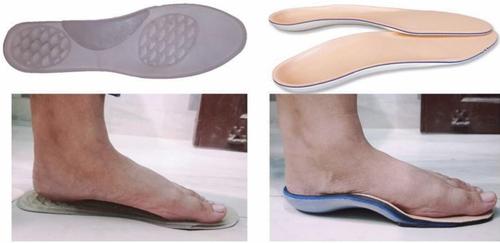Indian Journal of Orthopaedics ( IF 1 ) Pub Date : 2022-07-20 , DOI: 10.1007/s43465-022-00699-0 Amit Kumar Vimal 1 , Shivani Sharma 1 , Bindu Gahlawat 2 , G Pandian 1 , Sumit Sural 3

|
Background
Flexible flat foot or pes planovalgus is a common foot deformity, and silicone and customized insole are commonly used as a non-operative treatment modality of flexible planovalgus. However, there are inadequate data and limited evidence available regarding the immediate effects of their use in midfoot and hindfoot of adults. The aim of this study is to quantify and compare the radiological parameters immediately on weightbearing with silicon and customized insoles and without them to assess the effect on midfoot and hindfoot of the flexible planovalgus in adults.
Methods
A total number of 11 (8 females and 3 males) subjects with flexible pes planovalgus deformity without any other foot deformity were included in the study. Each patient was assessed three times in a random sequence without and with use of either silicon insoles or customized insole. The radiographic parameters without insole, with silicon insole, and with customized insole conditions were calculated using online available computer software Kinovea.
Results
One-way ANOVA analysis was performed between groups (without insole, with silicone insole and with customized insole). The hindfoot parameters depicted that calcaneal inclination angle (CIA) was significant increased (P = 0.000) and talar declination angle (TDA) was significantly decreased (P = 0.003) only with the use of customized insole compared to without insole. The midfoot parameters depicted that the first metatarsal angle (FMA) and talonavicular coverage angle (TCA) were significantly lower with customized insole (P = 0.00) as compared to other two groups and significantly lower with silicone insole (P = 0.00) as compared to without insole group.
Conclusion
The results imply that the compressibility of the insole material affects the forefoot and hindfoot biomechanics differently. This study concludes that silicone insole affects only the midfoot which bears 45% of bodyweight and customized insole affects both midfoot and more importantly the hindfoot which bears 55% of bodyweight.
中文翻译:

定制鞋垫和硅胶鞋垫对成人柔韧平外翻足中足和后足的影响
背景
柔性扁平足或 pes planovalgus 是一种常见的足部畸形,硅胶和定制鞋垫通常用作柔性扁平足的非手术治疗方式。然而,关于使用它们对成人中足和后足的直接影响,没有足够的数据和有限的证据。本研究的目的是量化和比较使用硅和定制鞋垫与不使用硅鞋垫和不使用它们的情况下负重时的放射学参数,以评估成人柔性外翻对中足和后足的影响。
方法
共有 11 名(8 名女性和 3 名男性)患有柔韧的外翻足畸形但没有任何其他足部畸形的受试者被纳入该研究。每位患者在不使用和使用硅鞋垫或定制鞋垫的情况下以随机顺序评估 3 次。使用在线可用的计算机软件 Kinovea 计算无鞋垫、硅鞋垫和定制鞋垫条件的射线照相参数。
结果
在各组(无鞋垫、硅胶鞋垫和定制鞋垫)之间进行单向方差分析。后足参数显示跟骨倾斜角 (CIA) 显着增加 ( P = 0.000),距骨偏角 (TDA) 显着降低 ( P = 0.003),仅使用定制鞋垫与不使用鞋垫相比。中足参数显示,与 其他两组相比,定制鞋垫的第一跖骨角 (FMA) 和距舟覆盖角 (TCA) 显着降低 ( P = 0.00),与硅胶鞋垫 相比( P = 0.00) 显着降低没有鞋垫组。
结论
结果表明,鞋垫材料的可压缩性对前足和后足生物力学的影响不同。该研究得出结论,硅胶鞋垫仅影响承受 45% 体重的中足,而定制鞋垫影响中足,更重要的是影响承受 55% 体重的后足。


























 京公网安备 11010802027423号
京公网安备 11010802027423号